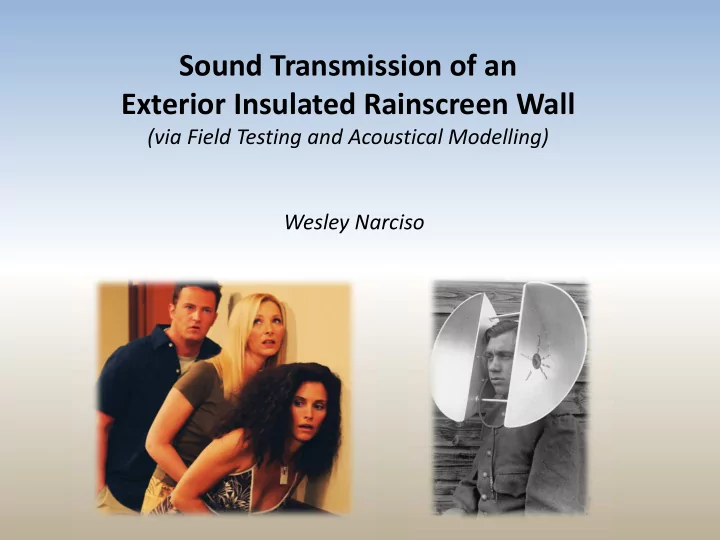

Sound Transmission of an Exterior Insulated Rainscreen Wall (via Field Testing and Acoustical Modelling) Wesley Narciso
Outline of Presentation Introduction Field Testing (Intensity Probe) Acoustical Modelling (SoundFlow) Summary Results and Discussion
Introduction Drivers of building envelope design Heat, air, moisture, vapour . . . . . acoustics Lack of sound transmission field data, especially for walls Consulting industry Letters of assurance (Schedule B – Sound Control) Especially in noisy areas (e.g. bus stops, skytrains, railways)
Field Testing
Field Testing
Field Testing Wall Schedule Gypsum wall board (0.5”) Fibrebatt insulation (6”) PT Plywood sheathing (0.5”) Moisture/air barrier XPS (1.5”) Wood furring (0.5”) Cedar shingles (0.5”)
Field Testing Test Procedure Temperature and humidity Façade dimensions (all areas) Background noise Set speaker inside room Measure sound pressure in room Measure sound intensity at wall exterior (discrete locations within a grid) Equipment Omni-directional speaker Intensity probe (GRAS) Soundbook and Samurai software 831 sound meter (Larson Davis)
Field Testing
Field Testing Transmission Loss and OITC Values 60.0 50.0 Transmission Loss (dB) 40.0 30.0 20.0 10.0 0.0 100 125 160 200 250 315 400 500 630 800 1000 1250 1600 2000 2500 3150 4000 5000 Frequency (Hz) Wall Window Composite Window and Wall STC Reference Curve
Field Testing Comparison with Laboratory Testing (IRC/NRC Report) Wall Type OITC STC Face-sealed, vinyl clad 25 37 Rainscreen, vinyl clad 25 37 Face-sealed, vinyl clad (exterior insulated - 1" rigid fibre) 25 37 Face-sealed, vinyl clad (exterior insulated - 1" EPS) 26 37 Facade Specimen - rainscreen, cedar clad, 1.5" XPS 26 36 Face-sealed, vinyl clad (additional GWB) 27 39 Face-sealed, EIFS clad 27 38 Face-sealed, stucco clad 29 40 * Other OITCs and STCs are taken from the IRC/NRC Internal Report, October 2000, Bradley and Birta (similar stud size and spacings to test wall)
Acoustic Modelling SoundFlow software Simulation software for calculating the absorption, reflection, and transmission of sound by multi-layer structures Assumptions Properties Areas Air gaps A/V barrier
Acoustic Modelling Transmission Loss of Test Wall 160 Split Insulated Rainscreen Wall OITC STC 140 Field Tested 26 36 120 Acoustically Modelled 27 31 100 Transmission Loss (dB) 80 60 40 20 0 50 63 80 100 125 160 200 250 315 400 500 630 800 1000 1250 1600 2000 2500 3150 4000 5000 Frequency (Hz) Wood Framing Wall Cavity Window Entire Composite Facade Studs and Cavity Composite STC Reference Curve
Acoustic Modelling Transmission Loss and OITC Values 50 45 40 35 Transmision Loss (dB) 30 25 Wall Type OITC STC 20 Empty Cavity – No XPS 20 29 15 Empty Cavity (4.5" XPS) 21 30 Batt in Cavity (3“ XPS) 27 31 10 No XPS - Just rainscreen 27 31 5 Test Wall 27 31 0 50 63 80 100 125 160 200 250 315 400 500 630 800 1000 1250 1600 2000 2500 3150 4000 5000 Frequency (Hz) Empty Cavity More XPS Empty Cavity (but 4.5" of XPS) No XPS (just rainscreen) Test Wall
Summary of Results and Discussion Based on Field and Laboratory Testing Test Façade Great wall for heat, air, moisture and vapour, but not so great on sound insulation Windows - better at most lower frequencies Wall - better at most higher frequencies Exterior Wall Design What’s best for traditional/current BE design is not always best for sound insulation Stucco does well for acoustics but . . . Rainscreening doesn’t help with acoustics Exterior insulation had little effect Adding GWB can be a cheap and easy way to improve sound insulation
Summary of Results and Discussion Based on Acoustical Modelling OITCs are possible to compare and correlate Removing batt insulation is detrimental (even if you add exterior insulation); keep some sound absorbing material in the cavity (min 50 mm); split insulation is optimal Adding/doubling exterior thermal insulation (rigid) improves very little sound insulation
Recommend
More recommend